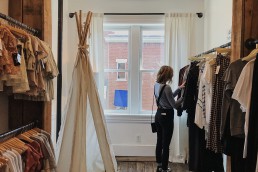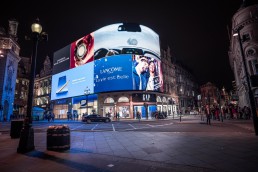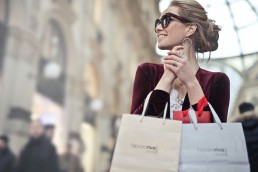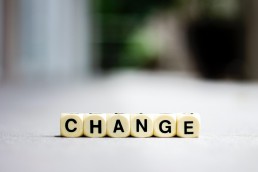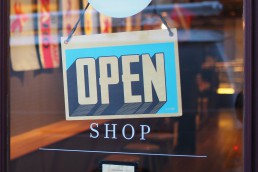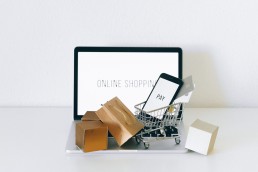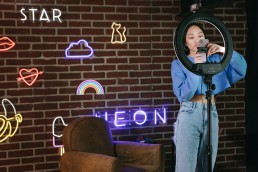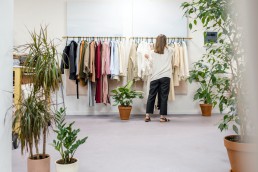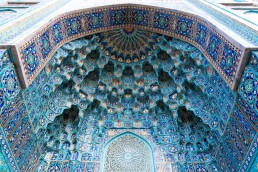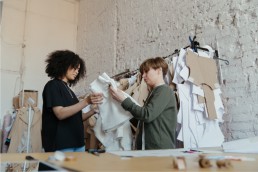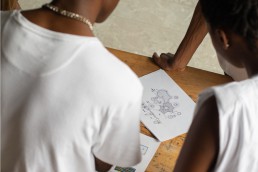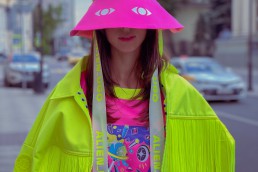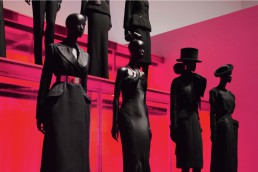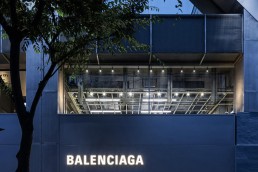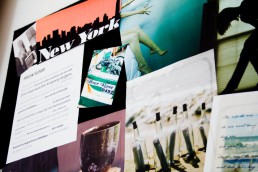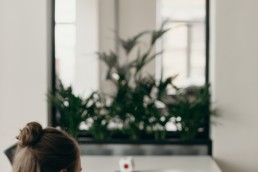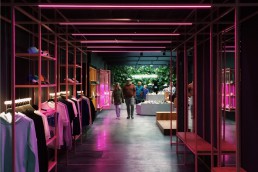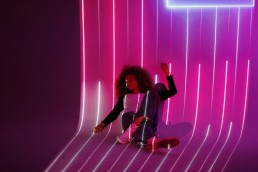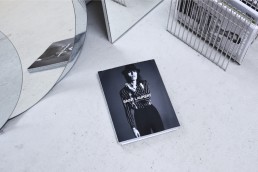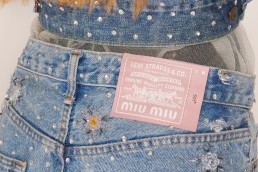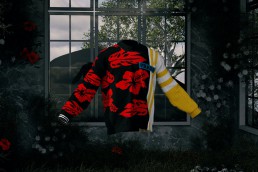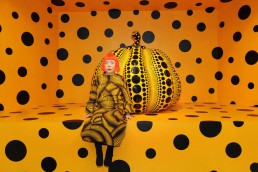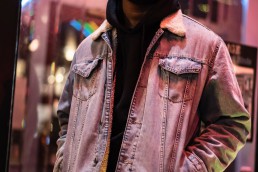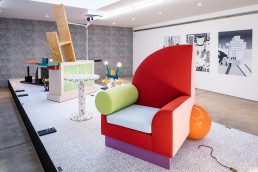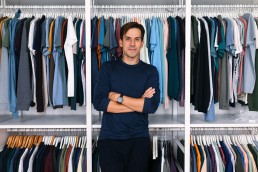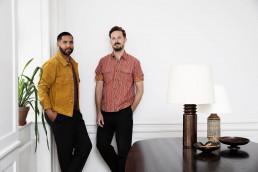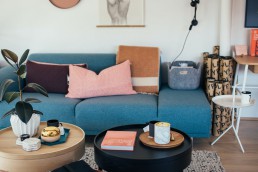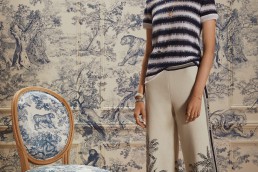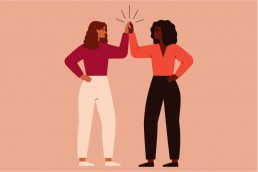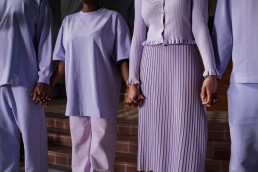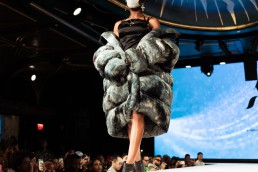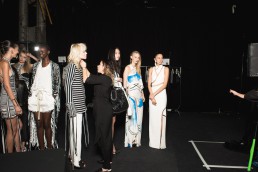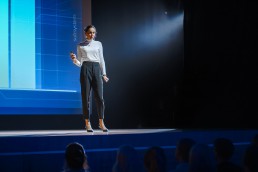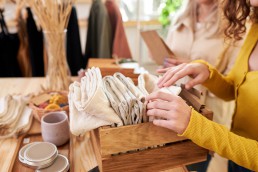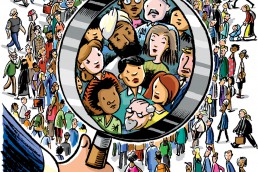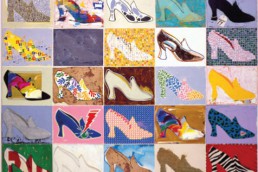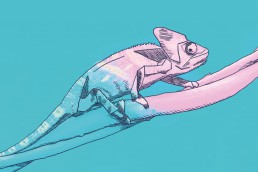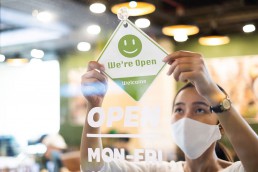The Importance of an Omnichannel Visual Merchandising and Styling Strategy
The way a brand showcases its products can affect customer perception and desirability over time. Today we share key aspects in a brand’s visual merchandising strategy.
The visual experience of a brand integrates all aspects of communication touch points within its audience. Retail, seen from the omnichannel perspective, is continuously evolving and merging inputs from physical outlets to online destinations. Customers are currently looking for brands that show their purpose and activate it through experiences, storytelling and emotive imagery.
The brand’s visual strategy has to be consistent through values, aesthetics and recognizable elements associated with the brand. It is the only way to connect and leave a memorable impression.
The pandemic has accelerated all business digitalisation. By 2025, the online sales will represent 21% of total retail spending, according to a forecast of Euromonitor International. They stated that the market opportunity to make additional e-commerce sales coming into the pandemic for brands was $77.7 billion.
Michelle Evans, Senior Head of Digital Consumer at Euromonitor International, stated in a Forbes article that e-commerce has been the fastest-growing channel over the last ten years, and apparel and footwear are expected to drive the greatest absolute value growth in the next lustrum.
However, with lockdowns in major cities, restrictions in travelling, and limited social interactions, customers are willing to take back the streets and retail stores to do “revenge shopping”, a reaction after quarantines, making up for the “time lost”. This coined term explains, for example, the Guangzhou phenomenon last year, when Hermès Paris, reopened its flagship store and made up $2.69 million in a day, according to WWD.
Omnichannel Perspective and the Shopper’s Experience
Darrell K. Rigby, a pioneer author on the subject, considers an omnichannel “an integrated sales experience that melds the advantages of physical stores with the information-rich experience of online shopping”. Researchers Kamel and Kay, complement this vision with the desire to serve the customer “whenever and wherever they wish to purchase merchandise”. It is the customer-centric perspective that allows the integration of various channels serving their choice.
Frazer and Stiehler, argue in “Omnichannel Retailing: The Merging of the Online and off-Line Environment” about a seamless shopping experience from an experiential marketing approach: “focusing on the contact points where the retailer could evoke shoppers’ sense, feel, think and act reactions”. In this case, physical retail is the king, though, online experience is richer in communication interaction and reach, in addition to integrating a faster and flexible way of testing elements.
Visual Merchandising: Creating Amazing In-Store Experiences
Visual merchandising is the process of presenting and displaying merchandise through any trading environment. The discipline focuses on catching client’s attention and interest, a physical way to enhance the product, raising brand awareness and hopefully, encouraging a transaction.
The visual retail strategy aims to present the product at its best, increasing their perception value through creative-display atmospherics setting the tone of a concept presenting a collection or a brand’s identity.
A good visual merchandising strategy can lead into PR coverage, to demonstrate, famous department stores such as Harrods or Selfridges, unveiled their seasonal storefront to the public with incredible set design and decoration. The work of David Hoey, senior director of visual presentation at Bergdorf Goodman and pioneer window dresser, is a good example of conceptualisation, craftsmanship and vision, to develop a point of view to attract customers.
“Nowadays, people are looking for a re encounter with nature, craftsmanship, raw materials, sustainability, reuse. It is not new because some brands (our client Loewe, for example) have been doing it forever”, states Jose Luis Suarez, CEO of DPS Production a company specialised in visual merchandising to develop and communicate creative concepts, with clients such as, Celine, Berluti, Dyptique, Chanel, John Lobb, Stella McCartney, Hermès among others.
For Suarez, the craftsmanship in visual merchandising and store atmosphere is more than a fad. “We love to work with Potters, wickerwork or plaster objects; there is a richness in the hand work, an unexploited natural perspective”
There are key elements in the field of a good visual merchandising strategy such as, logical positioning and adjacency, clear labelling of information, a balance in sensory experience, clear garment disposition and colour coordination – all to help the client to understand how to wear the product, and where to find it-, and a punch innovative style concept.
The quality and design of a store is a fundamental part of the marketing mix, as it is the brand’s core distribution place, as well as part of its communications strategy as a promotional tool.

For example, the Dior boutique aesthetic was created by Victor Grandpierre, a Christian Dior’s long-life collaborator. He created the Versailles inspiration, merging together the Louis XVI chairs, the Austrian shades, the signature grey-and-white palette, evoking a “cabinet de curiosités”.
Last July, the brand unveiled a new boutique on Rue Saint-Honoré, showcasing the Dior’s heritage and codes designed by famous architect Peter Marino. It is a new stone edifice with double-height glass windows on the lower floors’ blends with the remaining portions of the 18th-century building. On the walls, the classic Toile de Jouy canvas, nods to the founding couturier’s first boutique in Avenue Montaigne and a key element in the brand’s visual aesthetic.
“The physical shop allows you to have a complete experience. The customer is immersed in the brand’s space, it is the perfect spot where the brand can transmit its message, values, identity, with strength and passion, “without passion, there is no branding”, comments Suarez, as physical stores still are a key driver for sales.

Understanding Online and Physical Channels as One: Insights to Develop an Effective Dynamic
With the consumer behaviour changes, with the last months in mind, a clever approach for any brand or business now is to accelerate its digital development. Showcasing products online – the right way- is crucial too, in order to offer an alternative experience to the client with a faster approach and variety of products to decide.
“The experience must be 360°, what the customer sees online must be represented in the physical space, and vice versa, both image and visual departments could create concepts and atmospheres together developed in a way that best suits each channel”, states Daniela Cataldo, Art Director and Stylist, who has worked for international fast fashion apparel Inditex group brand, Oysho, styling the campaigns and coordinating photoshoots of the collections.
The e-visual image in a website is crucial to digitally build what the brand has done in physical channels. Editorial shootings, video campaigns, and of course, the product itself. A photographed garment has not the same level of attitude as the real piece, however, the duty of an e-stylist is to create the same effect, to raise desirability and to present it in sync with the style recap of the season.
E-commerce models wear clothing that would be held in mannequins within the store come to life. From the client’s perspective, the result is different in both occasions, in-store they can touch it and try it on; online, they can be reflected in a human model, generating an aspirational connection.
The mind is a powerful driver for imitation. “There are models that really sell everything they put on! Of course, you need to develop good creative concepts and adequate lighting and photography, yet it is the casting that really gives the image its strength” comments Cataldo, as the results are very evident in terms of product sales.
The focus on market needs requires continuous commercial analysis and coordination with visual merchandising teams for visual coherence between online and physical outlets; only some of the back-office tasks to create an efficient omnichannel visual strategy.
You need to be very User Experience (UX) oriented to test the e-commerce platform, simplifying steps, giving recommendations of products or similarities, in addition to delivering amazing photoshoots with a high level of production and retouching to make the garments shine without creating false expectations. “I call e-styling ‘the silent hand’, it is a job that requires a lot of attention to detail, being in many places at once, but when it is done well, it goes unnoticed”, Cataldo states.
As for the “revenge shopping” phenomenon, Suarez believes in the power of the experience as a driving force for people to return to physical stores. “Online and Offline should not be seen as a dichotomy, because both worlds mix together. Some product categories may not be a dream experience, however if you want to buy an Hermès Carré, the online shopping experience cannot replace walking into an Hermès boutique and being immersed into the brand’s world”, concludes.
The importance of visual merchandising from the omnichannel perspective is crucial to all fashion brands and lifestyle businesses, who want to lead the new worldwide dynamics, where physical and digital merge.
In a “Zoom” world, we are yearning for a reality check, to have tangible experiences without giving up technology, as life itself is more than staring at a screen.
Fernando Aguileta de la Garza
The Rise of the Resale Market: The Landscape Inside the Fashion Industry’s New Mindset
The clear changes in consumers habits, their relationship with ownership and buying behaviour has challenged fashion’s business models. The circular economy perspective is gaining followers in the market beyond a simple trend. Are we ready to close the loop?
The second-hand market is expected to hit $64B in 2024, overtaking the tradition thrift and donation segment, according to Thredup’s Annual Resale Report in partnership with GlobalData. Forbes Magazine predicted that by 2025, resale of fashion goods, such as sneakers and other collectibles, could reach $6B in sales.
With these numbers at hand, there is no doubt the resale market is tremendously blooming thanks to Internet and digital ventures through all fashion segments. It is not only a shift inside the consumer’s process of product acquisition equation, it is a rediscovery of the value of things made to last, at least longer, and completely opposed to fashion’s rapid obsolescence.
Resale, vintage fashion, or the second-hand market are not new concepts, however, its hybrid approach with technology certainly is. In the last decade several platforms and online consignments have grown a selective or massive clientele willing to buy, trade, or sell their clothing.
In this context, with the ease of e-commerce, peer-to-peer exchanges, or even auction services, the consumer has found a valuable offer of clothing and accessories to buy compared to the full-price market. Additionally, when consuming second-hand, the customers are cultivating a responsible commitment to sustainability and curbing wasteful consumption.
Circular Economy in Fashion and Its Approach to Sustainable Development
According to researcher, Kirsi Niinimäki, leader of the Fashion/Textiles Futures research group in Finland’s Aalto University, a circular economy approach in the fashion industry “aims to develop a more sustainable and closed-loop system where the goal is to extend the use- time of garments and maintain the value of the products and materials as long as possible”.
In the circular economy it is necessary to take a system perspective on fashion’s valuable supply chain, including all members as designers, producers, manufacturers, business entrepreneurs and of course, the customer.
Optimisation of use, or utilisation of manufactured goods is at the core of the circular economy’s perspective, as opposed to the traditional focus on the optimisation of the production of the objects up to the point of sale as new items; a straightforward goal in sustainable development.
The new models of production and consumption regarding circularity involve concepts such as sharing, leasing, reusing, repairing, refurbishing and recycling existing materials or products as long as possible. With this approach, the life cycle of products is extended and in fact, we are encouraging to reduce waste to a minimum.
Creating value through keeping materials to be used another time or cycle, either through exchange or reuse. For example, in March 2020 the European Commission presented the new circular economy action plan under the “European Green Deal”, including proposals on more sustainable product design, reducing waste, and empowering consumers to demand new industrial commitments in resource intensive sectors, such as electronics, plastics, construction, and of course, textiles and fashion.
In February 2021, the Parliament demanded additional measures to “achieve a carbon-neutral, environmentally sustainable, toxic-free, and fully circular economy by 2050, including tighter recycling rules and binding targets for materials use and consumption by 2030”.
The future success of circularity means adopting a new, more strategic mindset inside of the company, in all of its activity, including their way of producing and reducing environmental impact. To change the linear model, strategists and fashion executives have to focus on the lifecycle and regeneration of products in aim to closing the material loop.

Fashion’s Landscape of Resale Market: From Luxury to Mass Market Players Changing the Rules
Thanks to technology, new ventures are developing and creating value for the broad range of average fashion users. The collaborative consumption has gained relevance as a top disruptor in the fashion industry and lifestyle sector. Collaborative Consumption, as a business structure, is characterized by trading, renting, gifting, sharing, bartering, lending and swapping goods or services using digital mediums such as apps or platforms.
The San Francisco giant, The Real Real and Paris-based, Vestiaire Collective are a luxury destination for vintage clothing and second-hand luxury items and premium brands.
The Real Real, created by founder and CEO Julie Wainwright a decade ago, is one of the leading players of the resale market, with innovative initiatives and building a community of shoppers and consignors. With a clear strategy including retail locations and strong partnerships with luxury brands such as sustainable pioneer, Stella McCartney, Burberry with the #ReBurberry action and lately, The Real Real X Gucci, with a growing performance in resale value and searches inside the platform.
“Together we’re shining a global spotlight on resale that we hope will encourage all consumers to support the circular economy and join us in reducing fashion’s carbon footprint” stated Wainwright in a press release about the collaboration.
The latest on the startup is “ReCollection”, a recycling luxury ready-to-wear and handbags line. The platform is upcycling luxe fibers and fabrics and turning them into high fashion in partnerships with top brands like Balenciaga, Dries van Noten, Stella McCartney, A-COLD-WALL, Jacquemus, Zero + Maria Cornejo, and Ulla Johnson.
Vestiaire Collective launched a “Brand Approved” page on their app and website in partnership with Alexander McQueen, to showcase an archival sale and resale items to embrace circularity. They also featured hard-to-find sale items from its sellers’ network in collaboration with Selfridges, proving luxury’s secondary market interest is strong and rising.
Last March, Vestiaire Collective announced a new €178m financing round backed by Kering Group and Tiger Global Management to accelerate its growth in the second-hand market and drive change for a more sustainable fashion industry. Kering’s business strategy is supporting innovative business models, embracing new market trends and exploring new services to fashion and luxury customers.
Vestiaire Collective’s sustainability roadmap includes empowering and growing its community of “fashion activists” through the “Fashion Activist” badge and “Follow the Leaf” program. Also, reducing environmental footprint, to be carbon neutral by 2026 and obtaining B Corp certified business status.
“This latest round of investment confirms the incredible trajectory of Vestiaire Collective, founded during the 2008 crisis, the model has clearly demonstrated its ability to continue to thrive during challenging conditions. The resale sector as a whole is experiencing rapid growth, especially amongst Millennial and Gen Z consumers, which will come to shape the retail landscape of the future”. Maximilian Bittner, Vestiaire Collective’s CEO

In a different target and value positioning we find ThredUp and Depop, as resale platforms with a global reach, engaging with younger consumers through a marketplace format.
James Reinhart, founder of ThredUp, focuses on “inspiring a new generation of consumers to think secondhand first”. His revolution landed a public IPO this March, giving the company a valuation of $1.8 billion dollars with 1.24 million active buyers inside the platform.
Besides creating a brand intelligence division through insights, reports and statistics, Thredup has been exploring, as well as its competitors, strategic partnerships to push forward the second-hand movement. The platform teamed up with New York Designer Christian Siriano to bring circularity to the forefront of the fashion week. Sirano sourced thrifted pieces from the Thredup and presented it as part of his FW 21 fashion show.
Examples of brand initiatives include the “ReFashion Collection”, an initiative made in partnership with Zero Waste Daniel brand, and the partnership between Olivia Wilde and Conscious Commerce where they released an used clothing collection to fight disposable fashion culture to name a few.
“Clothes are not trash. It’s time to put an end to planet-harming throwaway fashion habits. We hope this collection will inspire consumers to thrift more, toss less and get creative about how they breathe life into old clothes through DIY”. Erin Wallace, VP of Integrated Marketing, thredUP

Depop, with 90% of active users under the age of 26 and more than 26 million registered users over 147 countries, started in 2011 as a social network and has now transformed into an “all welcome” place to “like, buy, and sell” user favorite pieces or looks.
The platform is leading the streetwear and inclusion through collaborations with Vans, The Black Fashion Council, and last year with fashion designer Richard Quinn, where they launched a new and affordable collection of pieces designed and produced in his London studio to target his Gen-Z cult followers. In another chapter, the “Re/Sourced collection” was a celebration between the platform and Ralph Lauren celebrating his vintage Polo line.
Fast Company included Depop in their annual list of the World’s Most Innovative Companies for 2021. Its latest collaboration is a creative challenge inside their community using the iconic Adidas’ Stan Smith as an experimental canvas.
“We can reach and inspire more people to think about different, better fashion options that are kinder to the planet”. Peter Semple, Chief Brand Officer at Depop
Additionally, three Depop designers have been paired up with partners from the adidas family to rework and restyle classic secondhand adidas apparel.
Other resale and second-hand social selling platforms as Poshmark, Vinted, or the famous StockX inside the sneaker’s collector market, are redefining the sharing and value of pre-owned objects.
The new ventures based in circularity and responsible business mindset are key elements in the lifestyle and fashion industries trying to repair and fix past mistakes; aiming to build a better future, and contribute as key drivers to a rebirth of the fashion system.
Fernando Aguileta de la Garza
Innovation Strategy for Design Brands: Is Design Thinking the Best Approach?
Design is about enhancing the way you look at the world, beyond making something visually beautiful, better businesses combine design and strategy to identify and harness opportunities to drive change.
Introducing design principles to the strategic planning of an organization enables them to create new business models and help you decide which tools to use in order to learn something new, persuade others, but most importantly to take action and innovate.
It could be obvious that both fashion and interior design firms incorporate these principles when creating new products or services, however, the question is if they are using them to develop the core of business innovation: new systems, protocols, customer experiences, and even revenue models.
Innovation has become one of the most popular buzzwords in business, it seems it has as many different meanings as the people approaching it. Nevertheless, just like disruption and strategy, it is crucial to avoid this ambiguity in order to identify where we need to move forward as a company according to our long term vision.
Design thinking is one of the many creative tools and frameworks that gained popularity because the nature of the process allows teams to have valuable insights in a short period of time. IDEO, who has been acknowledged as the creator of the concept, defines it as “a human-centered approach to innovation that draws from the designer’s toolkit to integrate the needs of people, the possibilities of technology, and the requirements for business success”.
The starting point has to be a defined problem or challenge to solve, having a clear big question is the first step to think about the possible ways to approach it, the outcome of implementing a design thinking process should be the intersection between desirability, viability and feasibility.
When reading the definition one can understand why post-its have become a “must have” in every ideation meeting, according to Parson’s study Parts Without a Whole? – The Current State of Design Thinking in organizations‘, 75% of the consulted companies implement Design Thinking. It is important to acknowledge however, that the process itself does not guarantee innovation, it requires practice, a foundation of study, and probably an external consultant until the leadership team masters the new mindset.
A superficial approach might lead into unsatisfying results, mainly because the process is rushed, the investigation comes short or the team never moves into the implementation phase of the innovative solution. Parson’s study also adds that if Design Thinking is applied in an isolated manner instead of a mindset that goes through the entire organization, the chances of failing increase.

Where do I start? And more importantly, how do I know if this is the best approach for my brand?
- Understand your expectations and what you would like to accomplish: Success and failure often seem to be linked with the practitioners’ understanding of the concept itself. This means that you have to be aware of the context, but also know your team and their preferences, to choose what kind of design thinking they need. Leadership teams must be involved when solving innovation strategy issues.
- Assess if your brand has inhouse capabilities to introduce design thinking into the organization or if it is better to hire external consultants: Even though it is possible to self-train through literature, professional courses on both the concept and the process are the best approach if you want to lead the innovation strategy with this tool and move forward into a learning-by doing-phase, patience, time and dedication are needed to master the practice.
- Consider that an innovation strategy requires method, culture, and mindset: As stated previously, a superficial approach will lead into a superficial outcome. The only way to develop consistent innovation is to iterate the process, there is no unique answer since our customers, environment, technological needs and markets are in constant change. The good news is that Design Thinking is nurtured by iteration because every learning drives new insights.
Design brands are facing the challenge of reinventing themselves in uncertain times, a lot of the solutions we have seen are focusing on the symptoms instead of the problem. A product or marketing campaign that solves the short-term pain might not be suitable for the long-term challenge. The Design Thinking approach facilitates the understanding of these complex problems and a creative solution by asking the right questions and rethinking what you are doing.
It is important to notice that “creative” does not necessarily mean “disruptive” and that the success of the approach is achieved through discipline, focus and willingness to keep re-framing the problem as long as the circumstances keep changing.
Maria Mercedes Baltazar
How to Build a Viable Business Plan Following the Trend of Custom-Made Clothes
McKinsey’s report The State of Fashion 2020 forecasted the year “would open with the industry in a state of high nervousness and uncertainty, with most executives across fashion and the wider business world bracing for a slowdown in growth in the global economy”; “uncertainty” is definitely the keyword that better described the outcome.
As stated in the 2021 edition of the report, disruption accelerated responses that lead into positive outcomes, meaning “many fashion companies had to reshape their business models, streamline their operation, and sharpen their customer propositions[1].”
Customization, a concept that we’ve probably heard more than once in different business environments during the last year, has become one of the strategies to face the challenge of fighting for value, reducing inventory and dealing with the fact that “less is more” because more products do not necessarily yield more profits.
When thinking of fashion, tailor-made garments and shoes are between history and tradition, however, not so long ago it was the standard for selling clothes.Made-to-order, small batch and other customized production processes made a comeback in 2020, allowing the customer to have an active role at a certain phase before purchase. The trend started as an emerging issue a couple of years before, with the debate around a more considered approach to consumption looking for fewer and more lasting purchases.
As McKinsey’s report stated, the pandemic forced a lot of businesses to rethink everything and look for greater connection with their customers, even when traditional retail had to shift into e-commerce and digital platforms. Matching these needs with a more ethical approach turns into a competitive advantage for a certain niche of clients: offering a reduction of waste, better fitting, and participation in the process.
This trend is not for every company or fashion brand, it is on the opposite side from fast fashion because the model implies moving from automatization into craftsmanship at least at some stage, a more demanding communication with the client and longer production times.
However, if someone is planning to create a new brand; enduring revenue problems due to inventory; or is considering making a shift into their business model, now it’s a good time for working on a viable business plan.
It’s important to notice that in order to be scalable, a brand has to consider a hybrid customized product: basic sizes and custom-made details, basic models and different patterns, and so on. Otherwise, there is a risk of reaching maximum capacity in a short period of time.
For companies like Dessus Lingerie, a Mexican lingerie brand that sells worldwide entirely through e-commerce, shifting its business model from stock into a combination of “made to order” with custom-made details was the more reasonable decision to fulfill the value proposition and optimize revenue. Since the beginning of the company Ana Velázquez, the designer, envisioned a high quality product made to last in which every woman feels comfortable with themselves.
“One of the core values of the brand has always been the customization of key elements like fitting, however at the first stage of the company I tried to replicate the traditional business model of a bigger brand, which meant production in series for every collection. Soon, and painfully, I realized that it was both a financial and sustainable mistake”, said Ana while being asked about the previous business model.
After realizing that this way of work generated more waste on product cut, unsold stock pieces, and therefore less revenue, Ana made an iteration on the process and decided to produce only the pieces requested previously by clients and customize them as much as possible, considering fitting, fabric, colors and, since 2020, shapes. The clients perceived the changes in a positive way, with an increased sense of exclusivity and quality.
According to Ana, her customers are more willing to be patient in terms of production and delivery timing, due to the fact that they value the uniqueness of buying something that has been made following their requests and needs. Every collection has a reduced number of pieces, to avoid unnecessary waste, as well as keeping the models exclusive.
When being asked about the challenges of this kind of business plan, Ana replied that the first step is to understand that shifting into a 100% custom-made production might not be viable in terms of building a sustainable business. Adding up to the answer, she specified that from her perspective an entirely custom-made garment will be more similar to the experience of going to the tailor, where the client decides everything: from the design to the materials.
In Dessus she focuses on a 90%-10% balance: the client has the possibility of customizing 90% of the product while the other 10% is predetermined by the brand this includes patterns, certain shapes, design and potential fabric options to choose. Her advice is to find the “sweet spot” for your own company, where the clients feel happy with the outcome.
Another challenge to face is dealing with how accustomed we are to immediate satisfaction, especially when buying through e-commerce. Some customers want answers 24/7 and express delivery, those might not be for this kind of model, at the end of the day this trend means embracing slow fashion and having a deeper knowledge about the product you are getting.
Beyond the technical aspects of this model, communication becomes a very important feature in client service to manage expectations and understand the best way to optimize your process and maintain the business healthy.

As McKinsey’s report stated, the pandemic forced a lot of businesses to rethink everything and look for greater connection with their customers, even when traditional retail had to shift into e-commerce and digital platforms. Matching these needs with a more ethical approach turns into a competitive advantage for a certain niche of clients: offering a reduction of waste, better fitting, and participation in the process.
This trend is not for every company or fashion brand, it is on the opposite side from fast fashion because the model implies moving from automatization into craftsmanship at least at some stage, a more demanding communication with the client and longer production times.
However, if someone is planning to create a new brand; enduring revenue problems due to inventory; or is considering making a shift into their business model, now it’s a good time for working on a viable business plan.
It’s important to notice that in order to be scalable, a brand has to consider a hybrid customized product: basic sizes and custom-made details, basic models and different patterns, and so on. Otherwise, there is a risk of reaching maximum capacity in a short period of time.
For companies like Dessus Lingerie, a Mexican lingerie brand that sells worldwide entirely through e-commerce, shifting its business model from stock into a combination of “made to order” with custom-made details was the more reasonable decision to fulfill the value proposition and optimize revenue. Since the beginning of the company Ana Velázquez, the designer, envisioned a high quality product made to last in which every woman feels comfortable with themselves.
“One of the core values of the brand has always been the customization of key elements like fitting, however at the first stage of the company I tried to replicate the traditional business model of a bigger brand, which meant production in series for every collection. Soon, and painfully, I realized that it was both a financial and sustainable mistake”, said Ana while being asked about the previous business model.
After realizing that this way of work generated more waste on product cut, unsold stock pieces, and therefore less revenue, Ana made an iteration on the process and decided to produce only the pieces requested previously by clients and customize them as much as possible, considering fitting, fabric, colors and, since 2020, shapes. The clients perceived the changes in a positive way, with an increased sense of exclusivity and quality.
According to Ana, her customers are more willing to be patient in terms of production and delivery timing, due to the fact that they value the uniqueness of buying something that has been made following their requests and needs. Every collection has a reduced number of pieces, to avoid unnecessary waste, as well as keeping the models exclusive.
When being asked about the challenges of this kind of business plan, Ana replied that the first step is to understand that shifting into a 100% custom-made production might not be viable in terms of building a sustainable business. Adding up to the answer, she specified that from her perspective an entirely custom-made garment will be more similar to the experience of going to the tailor, where the client decides everything: from the design to the materials.
In Dessus she focuses on a 90%-10% balance: the client has the possibility of customizing 90% of the product while the other 10% is predetermined by the brand this includes patterns, certain shapes, design and potential fabric options to choose. Her advice is to find the “sweet spot” for your own company, where the clients feel happy with the outcome.
Another challenge to face is dealing with how accustomed we are to immediate satisfaction, especially when buying through e-commerce. Some customers want answers 24/7 and express delivery, those might not be for this kind of model, at the end of the day this trend means embracing slow fashion and having a deeper knowledge about the product you are getting.
Beyond the technical aspects of this model, communication becomes a very important feature in client service to manage expectations and understand the best way to optimize your process and maintain the business healthy.
[1] https://www.mckinsey.com/industries/retail/our-insights/state-of-fashion
Maria Mercedes Baltazar
How Companies Are Winning on Culture During COVID-19
Employees give leadership high marks for communication and integrity in the first six months of the pandemic.
At rst glance, you might expect COVID-19 to be a disaster for corporate culture. The widespread shift to remote work — half of employees in the U.S. were working from home in April — decreased the face-to-face interactions that reinforce organizational culture. The economic downturn in many industries and a spike in layoffs threaten to unravel the social fabric that holds companies together.
Our ongoing analysis of 1.4 million employee-written reviews on Glassdoor, however, tells a very different story. To examine how the pandemic has influenced employees’ perceptions of corporate culture, we looked month by month at how workers at Culture 500 companies rated their employer for the ve years through August 2020. When current or former employees review a company, they are asked to rate its culture and values on a five-point scale, from “very dissatisfied” to “very satisfied.”
We found that the average culture rating across the Culture 500 companies experienced a sharp jump between March and April 2020. (See “Company Culture and Values Ratings Before and During COVID-19.”) The months of April through August 2020, which saw widespread lockdowns, shifts to remote work, and layoffs, occupy the top ve spots in terms of average culture ratings during the five-year period.
To understand what was driving this positive spike in culture ratings in the COVID-19 era, we analyzed how employees discussed more than 200 topics in company reviews during the 12 months before the coronavirus pandemic. Our natural language processing platform identified which topics employees mentioned in the free text of their Glassdoor reviews and whether they talked about them positively or negatively. We then compared how often and how favorably those topics were discussed pre-COVID-19 with results from reviews written during the pandemic.
For most topics, there was little difference in sentiment before and during the coronavirus pandemic. But one important theme that does stand out in the months of the pandemic is the quality of communication by leaders. Employees of Culture 500 companies gave their corporate leaders much higher marks in terms of honest communication and transparency during the first six months of the coronavirus pandemic compared with the preceding year.
Do you want to read more? Please fill your email below and we will send it to you!
Donald Sull and Charles Sull(MIT Sloan Management Review)
Cooperative Advantage: Rethinking the Company’s Purpose
Pursuing a people-centered cooperative advantage can garner meaningful benefits for employees, customers, and community.
As companies reopen and recalibrate during these turbulent times, it’s worth asking whether they should resume business as usual or whether their true purpose should instead be reconceptualized. Indeed, capitalism itself is being challenged due to inequities in employment, health care, and education that the pandemic has only emphasized as the model’s limitations have been exposed. COVID-19 has ravaged the well-being of employees and communities and brought renewed attention to the racial injustice experienced by African Americans, much of which is structural and systemic. 1 Loyal employees who have been committed to their employers for many years are being unceremoniously let go. The leisure and hospitality sector, for example, has experienced massive layoffs at an unprecedented pace. 2
Management theory is mostly based on the writings of early 20th-century scholars whose research orientations were heavily grounded in economics and classical sociology. 3 These works portray human beings as an individualistic, utility-maximizing, transaction-oriented species. 4 In contrast, a recent op-ed by Al Gore and David Blood argued passionately for a more sustainable form of capitalism, asserting that CEOs must put the welfare of their employees first — as was practiced in the Black business community in the early 20th century.
During a period from 1900 to 1930 called “the golden age of Black business,” African American businesses experienced tremendous goodwill, support, and financial performance based on their pursuit of a cooperative advantage. We define cooperative advantage as the benefits that an organization possesses and accrues due to its people- centered approach to engendering a spirit of care and community, meaningful dialogue, and consensus building, for the bene t of employees, customers, and community.
Do you want to read more? Please fill your email below and we will send it to you!
Leon C. Prieto and Simone T.A. Phipps(MIT Sloan Management Review)
Craft Your Brand Strategy to Ensure Racial Justice
Consumers and employees are increasingly aware of brands’ positions on equality and fairness. Brand managers should consider these four steps in developing a strategy that embraces racial justice.
In fall 2016, Colin Kaepernick “took a knee.” Quarterback of the San Francisco 49ers, Kaepernick protested racial injustice by kneeling during the pregame national anthem. He instantly became a lightning rod for controversy; then- President Barack Obama voiced support, then-candidate and future President Donald Trump criticized, and the country was engulfed in a highly politicized and polarizing conversation.
It was a conversation that most brands (with the notable exceptions of Nike and Ben & Jerry’s) were uncomfortable having. They had been schooled in the practice of avoiding issues with even a whiff of politics, relying on guidance from the American Association of Advertising Agencies (4A’s), whose chief marketing o cer, Alison Fahey, asserted in 2017 that “consumers are not looking to brands to take a position on political or social issues. In fact, there’s typically more risk than benefit.” That was about to change.
In the summer of 2020, at a Chase Bank branch in New York, Jamie Dimon, CEO of global banking behemoth JPMorgan Chase, also took a knee in support of racial equity. Companies, even those of the size and stature of a big bank, were doing an about-face in standing up (or kneeling) for racial equity. The moment, however, was not without irony: The nancial services sector has a history of systemic racism dating back to its role in nancing slave ships and continuing with the 1930s practice of promoting segregation by geographic “redlining.” While some dismissed Dimon’s kneeling as a performative stunt, JPMorgan Chase backed up the gesture with a substantial $30 billion commitment to advance the cause of racial equity.
Brands in the Spotlight
The killing of George Floyd and Breonna Taylor by police o cers set off a groundswell that leaped across oceans to inspire protests for racial justice worldwide under the masthead of Black Lives Matter (BLM). A movement of this magnitude quickly crossed over into the marketplace: A survey conducted in early June of 2020 — two months after Taylor’s death and less than two weeks after Floyd’s — showed that 60% of the U.S. population expected brands to take a stand on racial justice, a majority that grew to 78% among respondents ages 18 to 34.
Do you want to read more? Please fill your email below and we will send it to you!
Dipanjan Chatterjee and Nick Monroe(MIT Sloan Management Review)
Changing Culture is Central to Changing Business Models
Leaders need to examine their core beliefs if they want to prosper in a COVID-19 world.
Culture is all-encompassing. It radiates through every action taken inside an organization — including deciding what is made and sold, which employees are hired and retained, which customers are serviced and how, what is measured and reported, and where time and money are invested.
However, while some leaders strive to create tomorrow’s cultural norms using advanced technologies, others resist cultural changes and stick to their knitting. The result is a growing chasm between winners and losers. For example, today’s trillion-dollar behemoths are all technology-based organizations that take advantage of mobile technology, data, multiple revenue streams, and AI strategies. They are led by leaders who want to change the world, while the companies that held the top spots of growth and value just two decades ago — banks, oil companies, real estate companies, and manufacturers — are paying the price for holding on to their historical cultural beliefs.
A good example of what’s at stake is the emergence of electric vehicles and Tesla’s rise to prominence as the most valuable car company in the world. In the companies that Tesla has surpassed, boards and leaders have resisted adapting to new cultural and technological realities. It’s not that the emerging cultural norms about the advantages of embracing modern business models have been unclear. It’s that while culture provides the foundation for organizational and industry stability, it is also the force that keeps leaders stuck in their old ways of conducting business. The takeaways from this story apply to every industry.
Leaders who are serious about creating the organizations of tomorrow have a simple choice: They can stay with the cultural norms that created their prior success, or they can do the hard work to change themselves to ensure success in the future. Today’s leaders need to take a personal journey to avoid the fate that has befallen companies such as Blockbuster, Kodak, Sears, and so many others, and it starts with three steps: examining personal values in order to rede ne them, communicating the new values widely, and measuring what matters — the performance of the new initiatives and investments that are necessary.
Do you want to read more? Please fill your email below and we will send it to you!
Lanham Napier, Barry Libert and K.D. de Vries(MIT Sloan Management Review)
The Opportunity of Circular Economy in the Evolution of Sustainable Fashion
For the last years we’ve seen sustainability evolve from a “nice to have” topic in the agenda into a “must have” in the strategy for almost every organization; textile and fashion industries have been key stakeholders in these conversations mainly due to the fact that “clothes are worn by almost everyone, nearly all the time” and also because it’s an industry worth 1.3 trillion USD and employs more than 300 million people along the value chain[1].
However, more than 80% of the clothes discarded worldwide become garbage because they are not produced to last, be reused or to biodegrade. This fact obliged the world to re-think about the impact of having 24 collections per year and the effects that fast fashion brands are having in the way we consume, use, and dispose garments.
In order to tackle that unfortunate tendency, companies like H&M and C&A have partnered with organizations like Ellen Macarthur Foundation to move from a linear model – take, use, waste- to a circular ecosystem that covers all parts of the business. “Repair, reuse, remake and recycle” is more than a marketing slogan, it’s a strategic consideration to take in when thinking about the future of a fashion brand.
Circular Economy comes as a compelling approach to reshape the way we visualize our business model with a sustainable perspective. In recent years this model has gained high-level political attention in Latin America and the Caribbean, from economic policies to public initiatives.
The COVID-19 pandemic has shown us the vulnerability of global value chains, the exacerbation of social inequalities and the depletion of natural resources, revealing all the shortcomings in the linear economy. It has also increased the time and effort we put into future thinking.
In our region we have at least three challenges to address: adding local value to compete with international brands, increasing collaboration between suppliers and customers and innovating to develop new processes and products. The circular economy offers opportunities to create regenerative value from our natural resources while pushing innovation.
But which are the core elements of a circular economy solution? The definition varies depending on the problems addressed, however we can identify the following core elements:
- Prioritizing regenerative resources by ensuring renewable, reusable, and non-toxic resources being utilized as materials.
- Stretching the lifetime: maintaining, repairing and upgrading the resources to maximize their lifetime or give them a second life through “take back” strategies (recycle or upcycle).
- Using waste as a resource: recovering waste for reusing and recycling when possible.
An important consideration to take into account is the switch from a linear model into a circular one doesn’t mean sacrificing revenue, it means looking for an innovative revenue model with a positive impact. The paradigm of circular economy aims to generate economic prosperity, protect the environment and prevent pollution[2].
Taking a look into the industry in Latin America, the latest figures in Statista show that the expected apparel market value for 2021 is USD 102,127 million in South America, USD 5,867 million in Central America and USD 24,158 million in Mexico, with women’s apparel as the largest segment, except for Mexico where men’s apparel takes the lead. In terms of growth, we can expect an average of 9.48%, mainly for non-luxury goods. These numbers reveal that LATAM is a market full of opportunities.
We need to rethink the business, looking for opportunities to create greater value and build on the interaction between products and services. This rethinking process has to consider the impact in every stage: reducing the production of waste from its design, since 80% of the environmental impact of the industry is generated at this phase, reusing resources at the highest possible value, and trying to return the used materials into the environment.
There are interesting companies such as LISH Clothing in Colombia which has the brand purpose of turning fashion into a sustainable industry with initiatives like buying local, fair prices for providers, small production, zero waste patterns, supra-recycling, amongst others.
Whether you are a small independent brand or a consolidated company, the key is about designing for the future with a systemic perspective that works with the supply chain, as well as internally within the organization.
[1] A New Textiles Economy: redesigning Fashion’s Future. Ellen Macarthur Foundation. 2017. https://www.ellenmacarthurfoundation.org/publications/a-new-textiles-economy-redesigning-fashions-future
[2] Prieto‐Sandoval, V., Jaca García, C., & Ormazabal Goenaga, M. (2016). Circular Economy: An economic and industrial model to achieve the sustainability of society. In Joanaz de Melo, J., Disterheft, A., Caeiro, S., Santos, R. F., & Ramos, T. B. (Eds.), Proceedings of the 22nd Annual International Sustainable Development Research Society Conference. Rethinking Sustainability Models and Practices: Challenges for the New and Old World Contexts. ISDRS, Lisbon, pp. 504–520.
Maria Mercedes Baltazar
Copenhagen Fashion Week: What Is Behind the Danish Strategy for Boosting Sustainable Development?
Copenhagen Fashion Week, a must-attend event for fashion insiders, positions itself as a pioneering platform in sustainability and leadership, with clear ideas about how the fashion week of the future should be.
“In order to be memorable, you have to be different”, as simple and classic as that has been the mantra for the danish fashion organisation, Copenhagen Fashion Week (CPHFW), home of a cluster of cult-referential nordic brands.
Last year, it took the lead in sustainability efforts creating a three-year plan aligned with The Sustainable Development Goals (SDGs) of United Nations, integrating tangible objective and commitments around the fashion event and exhibiting brands.
Inside the strategy it highlights the reinvention of traditional fashion events, and the innovation inside the core business model. The organisation aspires to lead by example in responsible business practices inside the fashion industry, motivating fashion brands to get into clear actions regarding environmental issues and their impact in order to start changing the system.
“I therefore believe they hold tremendous potential to drive change and, if we dare to be bold, we can change how business is done. We can move from being a source of inspiration and a conversation starter to a facilitator of action.” Cecilie Thorsmark, CEO, Copenhagen Fashion Week.
The main objectives for the plan and its positive implementation are, on one hand, in the event, settling goals to reduce and innovate, on the other hand, the industry, creating guidelines and requirements for a progressive transition to sustainable business operations.

Delivering Results Not Just Promises
The strategy is, in all ventures, a particular way of making things happen, a detailed plan for achieving success, and instructions on how to carry our processes in order to pursue a beneficial outcome for any industry
Without a strategy any action plan will fail, mainly because developing a strategy requires to analyse the past, rearrange the present and predict, somehow, the desirable future. In this context, it is important to get into actions, but it is more relevant to know where these are going to lead us.
CPHFW presented their 2020 annual report showcasing the specific areas of progress, besides their postponed goals due to Covid-19 restrictions. However, being transparent about it is setting a new standard to fight fashion’s opacity with specifics, as it “creates a possibility for knowledge sharing and conversations” according to the platform.
Regarding reducing climate impact, they have collaborated with Climaider, a certified gold standard carbon offset provider, to keep the CO2 emissions under control. Comparing its 2019 edition to 2020’s, they had a 50% decrease in their baseline of 45 tonnes of CO2, mainly due to low international travel. They have committed, once the pandemic is over, to remain focused on this area as smaller digital events, and the lack of travel are correlated with this positive result.
Travel emissions are a great concern for every fashion event, CPHFW is committed to reduce the impact with climate-friendly alternatives, using green energy, and establishing fees to name a few options.
In reducing resource consumption and waste creation, they completed their partnership’s objective to sustainable service as cutlery, tableware, straws for all shows and presentations. They update the Guide to a More Responsible Show, to reflect the gained knowledge and insights. From 2021 to 2022, they will be banning single- use materials, like hangers, garment plastic bags in any part of the show and event production in the hopes of achieving zero waste in brand’s presentations, as well as the fashion week’s own back office activities.

Partnerships and Accelerating the Industry’s Engagement
Implementing innovation inside business processes is hard work, as some structures refuse to change. However, change and collaboration have proven to be a smart way to jump into the future.
The CPHFW platform will continue their strategic partnership with Zalando towards 2023, as they share the same values concerning environmental and people impact. With the do.MORE strategy, Zalando wants to encourage circularity, sustainable choices, and raise ethical standards doing business.
The fashion week organisation has actively collaborated with the Dansk Fashion & Textile Institution, as well as developed a strong bond with the companies In futurum, and Rambøll, as knowledge and technical partners, respectively.
In futurum, is a consultancy founded by Frederik Larsen and Moussa Mchangama. Based in Copenhagen, they provide strategic advice on sustainable transition throughout core activities such as design, sourcing, logistics, communication, marketing and sales, as they are experienced professionals in the field of responsible business and lifestyle communications.
They are the mind behind their Sustainability Action Plan and the requirements and scoring for applicants to the Fashion Week. According to this, the 2023 Sustainability Requirements now comprise 18 minimum standards after adding the stipulation that brands must operate a safe, healthy, and respectful working environment for all employees, free from harassment and discrimination and where everyone enjoys equal opportunities regardless of gender, ethnicity, age, political/religious/sexual orientation, and physical appearance.

“Striving for sustainability is increasingly important, and in the face of a challenging year, it is paramount that we stay on course”. CPHFW, Annual Sustainability Report.

CPHFW activated the pilot survey test to create a baseline for the requirements last February. Any brand who wants to apply must consider the six areas required to submit an application: Strategic Direction, Design, Smart Material Choices, Working Conditions, Consumer Engagement and Shows. Applications are open until May 4th.
Each category has set minimum standards to meet plus additional actions to earn points. The goal is, by 2023, for all brands to obtain the required score to participate in the fashion platform. All indicators are in the open on the webpage including, innovative technologies as 3D and laser cut, circularity design, body inclusivity, source of materials (organic, recycled, upcycled), certifications, reselling and repairing services/policies, as well as overstock control.
“It was a great experience building a joint effort on bringing real change in the industry, and we are happy to see that the framework we developed is getting a lot of attention from other organisations, brands and media” says PhD. Frederik Larsen to ELLE Education as co-author for the recommendation standards. If the entire industry would rule by those parameters, a completely new system would emerge.
For the researcher, the Fashion Week format globally has to develop a new purpose in order to be relevant, as activities such as buying and presentation are increasingly developing online formats. “Fashion Weeks are the symbolic centre of the industry and could continue to be so with another meaning”, Larsen states.
If CPHFW achieves its targets by 2023, it is likely to set a benchmark for the rest of the industry as they keep providing accurate and tested frameworks in aims to transform fashion.
Fernando Aguileta de la Garza



